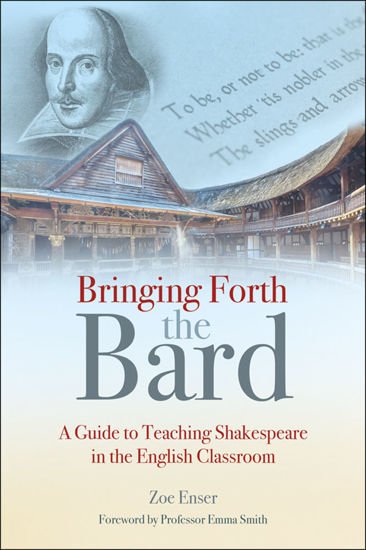Zoe Enser's 'Bringing Forth the Bard'
A book about both Shakespeare and teaching? Yes, please.
Zoe Enser’s recently-published Bringing Forth the Bard: a guide to teaching Shakespeare in the English Classroom will help teachers with little experience. But there is also much excellent material for old lags like myself.
The chapters are all headed ‘Bringing Forth …’ and cover Shakespeare’s world, his characters, allusions, themes, language, theatre and his abiding influence in modern culture. Enser’s central purpose is
To link together the golden threads that run across Shakespeare’s work, highlighting where you could explore these with students.
To do this we need deep subject knowledge:
Unless we have strong subject knowledge ourselves and have challenged our own ideas, misconceptions and interpretations, we are unlikely to be able to support our students to understand his work well.
Luckily we live in a very good era for intelligent and accessible writing about Shakespeare. A fine example is This is Shakespeare by Professor Emma Smith, who provides the Foreword to this book, commenting that
I admire the way this book combines openness to interpretation with clarity about how to work effectively with these texts. It points the way to a range of resources, many freely available online, from which teachers can develop their thinking and recharge their love of their subject.
From my own recent reading, I can recommend strongly to teachers James Shapiro’s Shakespeare in a Divided America, Scott Newstok’s How to Think Like Shakespeare: Lessons from a Renaissance Education, Kiernan Ryan’s Shakespearean Tragedy, R.M. Christofides’s Othello’s Secret: the Cyprus Problem and the many stimulating essays in The Cambridge Companion to Shakespeare and Race, edited by Ayanna Thompson. Those books engage thrillingly with the plays as they intersect with the contemporary world, freshening our understanding of the Bard. Zoe Enser, too, is determined to show how fruitful it is to follow the golden threads between the plays, as they weave in and out of cultural history up to the present day. She points out that Shakespeare himself did this:
The act of ‘imitatio’, where writers consciously make use of familiar ideas and structures, is a key element of Shakespeare’s writing and is deployed freely in his work.
(A chapter in Scott Newstok’s book is particularly good on ‘imitation’.)
As teachers we need to feel comfortable with the complexity of the plays, the ways they break boundaries and resist easy categorisation (think of the discomfiting non-comedic elements of Twelfth Night and The Merchant of Venice, and the strange comic features of the tragedy of Othello). We won’t bother here with the tired and lazy idea that Shakespeare is outdated, obscure and ‘irrelevant’. There is no school curriculum with Shakespeare as the only author, and there is no more vibrant story-teller to weave into a diverse curriculum. Why would you deny your students and yourself this opportunity?
The book also features helpful case studies by English teachers like Chris Curtis (on how fashion can give us insights into the plays), Heidi Drake (on power and leadership), Andrew Atherton (on Shakespeare’s poeticism) and Matthew Lynch (on images of birds and of hands in Macbeth - the latter being a thread I too follow in class). These suggest interesting ways we can deepen the experience of our pupils as we accompany them on their journeys through the texts. Each chapter also has sections on ‘How to teach it’ and ‘Applying it to the classroom’.
Though I am a secondary school teacher, I particularly like Lekha Sharma’s attitude in her piece on primary school children:
We must first wholeheartedly accept that the works of Shakespeare can indeed be taught at some intellectually honest level to pupils at any stage of education. It’s all in the delivery!
Just so. I have seen a production of Macbeth by primary school children (amazing) and I have a daughter who laps up the stories of The Comedy of Errors and A Midsummer Night’s Dream (I’ll wait a while for King Lear). As children get older, their engagement with these plays can become richer and more nourishing, and Bringing Forth the Bard is a valuable guide for teachers who are determined to make the most of that wonderful opportunity.
